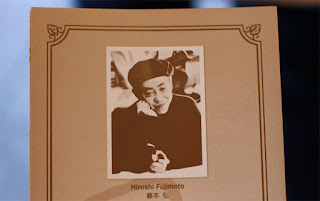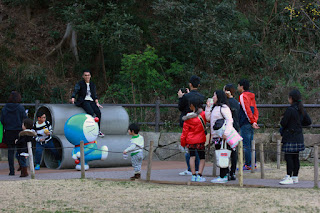First time going abroad for Footy. Japan!!! Yup, Japan.
Because there was a “Free Seat” promo from Air Asia 1 year before departure, we
were very tempted to buy two tickets. At first, we thought that maybe we would
spent about 7-8 days travelling in Japan. But guess what? We took 11 days
travelling time. We bought tickets from Jakarta (CGK) to Osaka (KIX) on March
19th, 2015 first because we had planned to come back to Indonesia from Haneda
Airport, Tokyo. So we bought those seperately (we can’t buy CGK-KIX/HND-CGK on
1 transaction only). At the end of our ticket hunting, we finally chose tickets
from Haneda (HND) to Jakarta (CGK) on March 30th, 2015 because the prices on
March 27-29, 2015 were unfortunately higher.
As the ticket itinerary showed, we would depart from 3rd
terminal of Soekarno Hatta Airport, Jakarta to Kansai International Airport ,
Osaka on March 19, 2015 20.15PM and then transit in Kuala Lumpur International
Airport (KLIA2) for about one hour and a half. Remember to come to airport two
hours before the departure time, especially, if you don’t do web check in first
in air asia website and still have a baggage with you. Also, bring along your
passport and ticket. We have already done web check-in (you could do it 14 days
before your departure time) and didn’t have any baggage so we just went to
immigration and airline’s document checking counter directly. Show them your
passport and e-boarding pass , if they ask. And here we are in the boarding
room before 19.45PM.
Unluckily, Air Asia informed us there was a delay on flight
from Jakarta To Kuala Lumpur for about one hour. No choices, we waited in the
boarding room that were more crowded from time to time. After about one hour,
the plane was ready to fly.
On the plane, everything was great. The stewards and
stewardess were kind, seats were comfortable eventhough this was a low cost
carrier and the journey were quite smooth. No extreme manuvere, no weather
problem eventhough we flew at night. The problem started after we landed in
Kuala Lumpur International Airport (KLIA2). Kuala Lumpur is GMT+8, one hour
faster than Jakarta (GMT+7). Normally the transit time was 90 minutes as the
schedule should be before the delayed time. We had a little chat with a woman
that sat next to Footy. Her friends then joined us too. We got pretty suprised
to know that they would stay in Japan until April 01, 2015. Thirteen
days in Japan, 3 women, backpacking style. Wow!!! But we suddenly reliazed that
flight for Kuala Lumpur to Osaka wasn’t delayed. So as we counted, the
transit time was just about 30 minutes and the flight would depart on March
20, 2015 at 01.00AM. We fastened our walk and left them behind after saying
goodbye. The airport was big and luxury, cafes and restaurants were all around
the boarding room. Instead of heading to the boarding room, we went to toilet in hurry because people had already queuing in front of the boarding room and the
announcement board wrote “Final call 12:40PM”. When we were about to fly, we
saw the woman that used to sit beside Footy entered the cabin but we didn’t see
the others.
Flight KUL – KIX is operated by Air Asia Benhard X(D7) and
uses Air Bus type that has a big capacity. This time, Footy sat in front of me
and it wasn’t matter for us. Nothing could be seen because it’s all dark out
there. If you do web check-in like we did, your seat will be picked
automatically by system. You have to pay more to pick desired seat location.
Inside the plane, there were a couple of Japanese sat next to Foody. The woman
could speak English fluently and no lack in intonation. She sat in an aisle
seat and his husband was in middle. I sat near the window. My skill of speaking Japanese was just
average so I thought it’s better for me not to try to talk to them and try to
have a good sleep because we’ll have a long walk after we arrived in Osaka.
Eating time!!!! Meals that we ordered, roasted chicken with
cranberry sauce (you can purchased meal before or on board, it was quite
efficient rather if you must buy some Malaysian Ringgits just to buy meal) was
served in a very big portion at 03.00AM.
The Japanese couple were still awake and ordered a cup of tea. Feeling embrasssed, I was about to talk “I will eat” to them but I felt it would be kind of strange so I just kept my mouth shut. When it was about 05.00AM, a stewardess asked once again whether there was passenggers that has ordered meals and not yet been served. Arghhh!!!! If we knew that it could be served at 05.00AM, we surely get it at this time. (Write in a note. Next time, you’ll know it. Hahahaha.......)
The Japanese couple were still awake and ordered a cup of tea. Feeling embrasssed, I was about to talk “I will eat” to them but I felt it would be kind of strange so I just kept my mouth shut. When it was about 05.00AM, a stewardess asked once again whether there was passenggers that has ordered meals and not yet been served. Arghhh!!!! If we knew that it could be served at 05.00AM, we surely get it at this time. (Write in a note. Next time, you’ll know it. Hahahaha.......)
Before the plane landed, we were told to fill a form for custom. If you are going to Japan with family members, then you need to fill one form only. But if you are going with friends, you all have to do each of yours.
Footy even managed to get a beautiful sunrise before we officially arrived. After the plane landed safely, I said goodbye to them, I
thought that it was the end of our meeting. But no, they showed us the way to
take a bus to the terminal, led our way to immigration section for foreigner.
Then they went to the right side which immigration counter for Japanese was located.
“電車 の事を分からなければ,駅員 に 聞いてください”
(If
you don’t understand about train’s stuff, please ask the station officer), he
said.
We
didn’t have any baggage so we went to custom checking directly while they were
still waiting for their baggages in the baggage belt. Custom officer told us to
take out stuffs from our backpacks as their normal checking procedure. Afraid
of someting that might happened to us, the old man approached us and asked.
問題 が ありますか。(Is there any
problem?)
ありません, 先生。(No, Sir)
After that, he went back to join his wife,
waiting for their baggages. We waved our hands from far away, saying thank you
and goodbye once again. Really friendly Japanese couple. The custom officer
finished checking out backpacks and we finally said thanks. We thought that we
would wait for them but custom officer told us to wait outside. After a long
flight (CGK – KUL = 90 minutes, KUL-KIX = 8 hours 25 minutes), we took a break
by sitting on a bench outside. For about 10 minutes then we went inside again.
Hope that we could get a picture with them but they were not there anymore.
ありがとうございます,伯父さんと叔母さん。あなた達に来年もまた会いたいです。
(Thank you, uncle, aunt. Hope we could meet you
again next year)
We eat, we walk, we talk
FoodyFooty2
contact and
follow us on:
email
: foodyfooty2@gmail.com
facebook :
foody footy
twitter : @foodyfooty2
instagram: @foodyfooty2








































